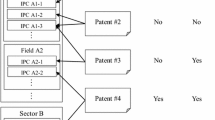Abstract
The objective of this paper is to depict the knowledge array of standards. This is done by identifying and analyzing external effects, specifically spillover effects. The database used is Perinorm. We use a cluster analysis in order to create groups of technology fields for German standards according to the fields of the International Classification of Standards. Methodologically, the distances between these objects or clusters are defined by the chosen distance measure, which in turn is determined by the sum of their cross references. The applied joining clustering method uses these distances between the objects and allows the data to be mapped within a two dimensional space. The results of this mapping show the existence of structures within the standards data fitting to the well-known structure of patent spillovers.
Similar content being viewed by others
References
Backhaus, K., Erichson, B., Plinke, W., Weiber, R. (1996), Multivariate Analysemethoden — Eine anwendungsorientierte Einführung, 8th Edition, Springer, Heidelberg.
Blind, K. (2000), Innovation, Normen und ihr Einfluss auf die gesamtwirtschaftliche Entwicklung, Zeitschrift Wirtschaftswissenschaftliches Studium, 29(4): 230–232.
Blind, K. (2004), The Economics of Standards. Theory, Evidence, Policy. Elgar, Cheltenham.
Blind, K., Grupp, H., Hullmann, A., Jungmittag, A. (2000), Gesamtwirtschaftlicher Nutzen der Normung. Zusammenfassung der Ergebnisse, DIN Deutsches Institut für Normung e. V. (Eds), Berlin: Beuth, p. 23, Retrieved 10 January 2005 from http://www.normung.din.de/sixcms_upload/media/1350/executive_summary.pdf
Blind, K., Jungmittag, A. (2005), Trade and the impact of innovations and standards: the case of Germany and the UK. Applied Economics, 37(12): 1385–1398.
Frietsch, R., Gauch, S. (2004), Patente in Europa und der Triade — Strukturen und deren Veränderung, Bundesministerium für Bildung und Forschung (Eds).
Gamber, T. (2005), Die ökonomische Auswirkung von Normen-Analyse zur Verflechtung der Technik an Hand von Verweisen zwischen Normungsdokumenten mit Hilfe der Datenbank Perinorm. DIN-Preiswettbewerb „Junge Wissenschaft“ 2005.
Grupp, H. (1996), Spillover effects and the science base of innovation reconsidered. An empirical macroeconomic approach, Journal of Evolutionary Economics, 6(2): 175–197.
Grupp, H. (1998), Foundations of the Economics of Innovation: Theory, Measurement and Practice, Elgar, Cheltenham.
Grupp, H., Legler, H. (2002), Germany’s Technological Performance 2001, Bonn: Bundesministerium für Bildung und Forschung.
Hanusch, H., Cantner, U. (1993), Neuere Ansätze in der Innovationstheorie und der Theorie des technischen Wandels — Konsequenzen für eine Industrie-und Technologiepolitik. In: F. Meyerkrahmer (Ed.) (1993): Innovationsökonomik und Technologiepolitik, Physika, Heidelberg, pp. 12–46.
Hotz-Hart, B. (2001), Innovationen: Wirtschaft und Politik im globalen Wettbewerb. Lang, Bern; Berlin; Frankfurt a.M.
Jungmittag, A., Blind, K., Grupp, H. (1999), Innovation, standardization and the long-term production function: A co-integration approach for Germany, Zeitschrift für Wirtschafts-und Sozialwissenschaften 119/1999, pp. 205–222.
Pleschak, F., Sabisch, H. (1996), Innovationsmanagement. Schäffer-Poeschel, Stuttgart.
Rogers, E. M. (1995), Diffusion of Innovations, 4th edition, The Free Press, New York.
Solow, R. M. (1956), A contribution to the theory of economic growth, Quarterly Journal of Economics, 70: 65–94.
Author information
Authors and Affiliations
Corresponding author
Rights and permissions
About this article
Cite this article
Gamber, T., Friedrich-Nishio, M. & Grupp, H. Science and technology in standardization: A statistical analysis of merging knowledge structures. Scientometrics 74, 89–108 (2008). https://doi.org/10.1007/s11192-008-0105-4
Received:
Published:
Issue Date:
DOI: https://doi.org/10.1007/s11192-008-0105-4




